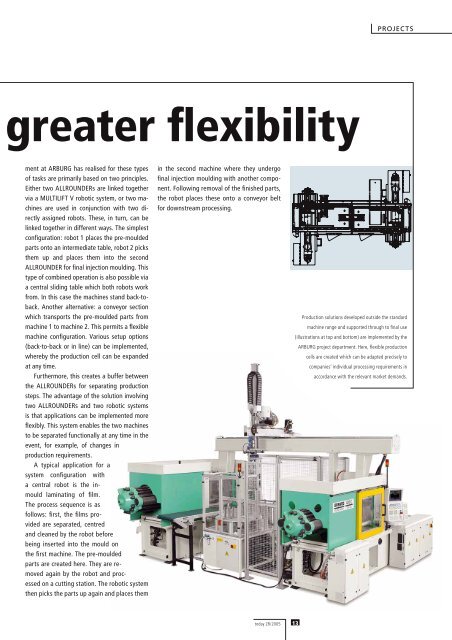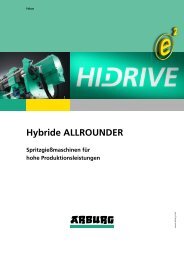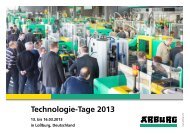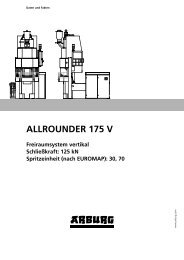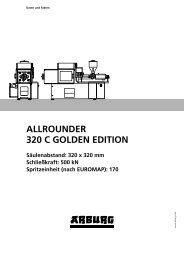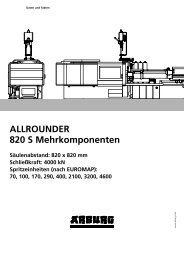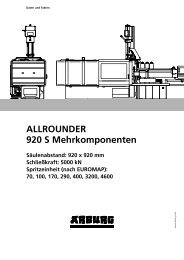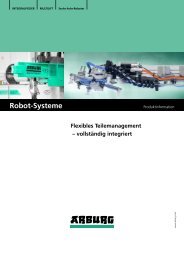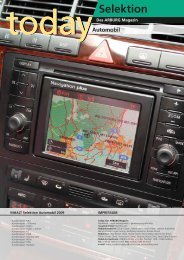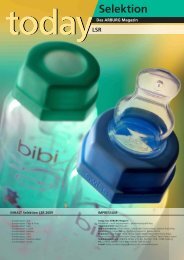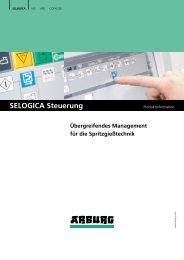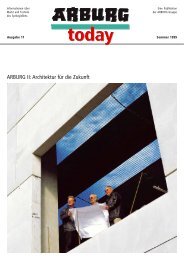GB - Arburg
GB - Arburg
GB - Arburg
Create successful ePaper yourself
Turn your PDF publications into a flip-book with our unique Google optimized e-Paper software.
greater fl exibility<br />
ment at ARBURG has realised for these types<br />
of tasks are primarily based on two principles.<br />
Either two ALLROUNDERs are linked together<br />
via a MULTILIFT V robotic system, or two machines<br />
are used in conjunction with two directly<br />
assigned robots. These, in turn, can be<br />
linked together in different ways. The simplest<br />
confi guration: robot 1 places the pre-moulded<br />
parts onto an intermediate table, robot 2 picks<br />
them up and places them into the second<br />
ALLROUNDER for fi nal injection moulding. This<br />
type of combined operation is also possible via<br />
a central sliding table which both robots work<br />
from. In this case the machines stand back-toback.<br />
Another alternative: a conveyor section<br />
which transports the pre-moulded parts from<br />
machine 1 to machine 2. This permits a fl exible<br />
machine confi guration. Various setup options<br />
(back-to-back or in line) can be implemented,<br />
whereby the production cell can be expanded<br />
at any time.<br />
Furthermore, this creates a buffer between<br />
the ALLROUNDERs for separating production<br />
steps. The advantage of the solution involving<br />
two ALLROUNDERs and two robotic systems<br />
is that applications can be implemented more<br />
fl exibly. This system enables the two machines<br />
to be separated functionally at any time in the<br />
event, for example, of changes in<br />
production requirements.<br />
A typical application for a<br />
system confi guration with<br />
a central robot is the inmould<br />
laminating of fi lm.<br />
The process sequence is as<br />
follows: fi rst, the fi lms provided<br />
are separated, centred<br />
and cleaned by the robot before<br />
being inserted into the mould on<br />
the fi rst machine. The pre-moulded<br />
parts are created here. They are removed<br />
again by the robot and processed<br />
on a cutting station. The robotic system<br />
then picks the parts up again and places them<br />
in the second machine where they undergo<br />
fi nal injection moulding with another component.<br />
Following removal of the fi nished parts,<br />
the robot places these onto a conveyor belt<br />
for downstream processing.<br />
today 28/2005 13<br />
PROJECTS<br />
Production solutions developed outside the standard<br />
machine range and supported through to fi nal use<br />
(illustrations at top and bottom) are implemented by the<br />
ARBURG project department. Here, fl exible production<br />
cells are created which can be adapted precisely to<br />
companies‘ individual processing requirements in<br />
accordance with the relevant market demands.


